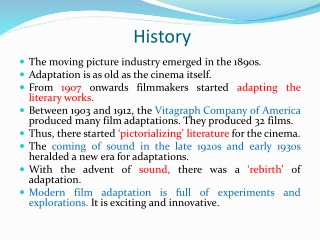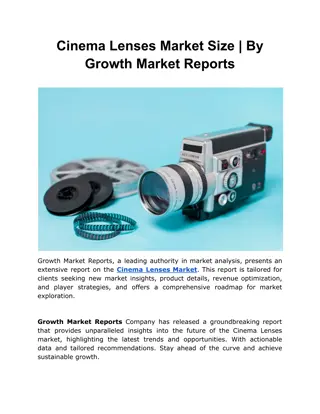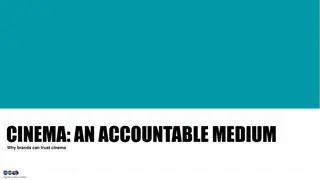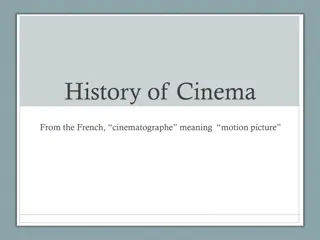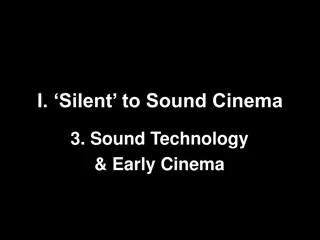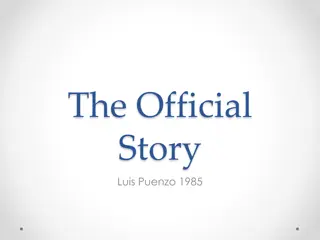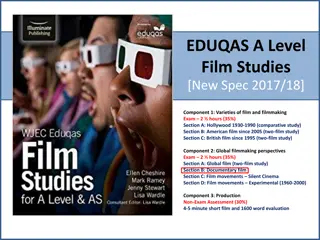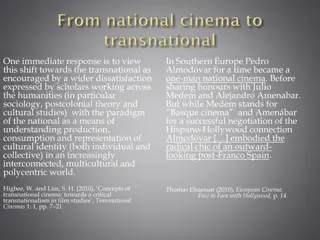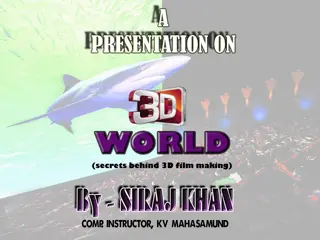Evolution of Cinema Industry
The evolution of cinema from its humble beginnings with the Lumière Brothers in 1895 to the Golden Age of Hollywood in the 1930s and 1940s. Explore the advancements in technology, storytelling, and the impact of major historical events on the film industry.
Download Presentation

Please find below an Image/Link to download the presentation.
The content on the website is provided AS IS for your information and personal use only. It may not be sold, licensed, or shared on other websites without obtaining consent from the author.If you encounter any issues during the download, it is possible that the publisher has removed the file from their server.
You are allowed to download the files provided on this website for personal or commercial use, subject to the condition that they are used lawfully. All files are the property of their respective owners.
The content on the website is provided AS IS for your information and personal use only. It may not be sold, licensed, or shared on other websites without obtaining consent from the author.
E N D
Presentation Transcript
Film studies UNIT-I
Origin of cinema The first to present projected moving pictures to a paying audience were the Lumi re Brothers in December 1895 in Paris, France. They used a device of their own making, the cinematography, which was a camera, a projector and a film printer all in one. THE RISE OF THE FILM INDUSTRY By 1914, several national film industries were established. At this time, Europe, Russia and Scandinavia were the dominant industries; America was much less important. Films became longer and storytelling, or narrative, became the dominant form. As more people paid to see movies, the industry which grew around them was prepared to invest more money in their production, distribution and exhibition. so large studios were established and dedicated cinemas built.
The First World War greatly affected the film industry in Europe, and the American industry grew in relative importance. The first 30 years of cinema were characterized by the growth and consolidation of an industrial base, the establishment of the narrative form, and refinement of technology. ADDING COLOUR Color was first added to black-and-white movies through hand coloring, tinting, toning and stenciling. By 1906, the principles of color separation were used to produce so-called natural color moving images with the British Kinema color process, first presented to the public in 1909. Kinema color was primarily used for documentary (or actuality ) films, such as the epic With Our King and Queen Through India (also known as The Delhi Durbar) of 1912, which ran for over 2 hours in total. The early Technicolor processes from 1915 onwards were cumbersome and expensive, and color was not used more widely until the introduction of its three-color process in 1932. It was used for films such as Gone With the Wind and The Wizard of Oz (both 1939) in Hollywood and A Matter of Life and Death (1946) in the UK.
CINEMAS GOLDEN AGE CINEMA S GOLDEN AGE By the early 1930s, nearly all feature-length movies were presented with synchronized sound and, by the mid- 1930s, some were in full color too. The advent of sound secured the dominant role of the American industry and gave rise to the so- called Golden Age of Hollywood . During the 1930s and 1940s, cinema was the principal form of popular entertainment. With people often attending cinemas twice a week. Ornate super cinemas or picture palaces , offering extra facilities such as caf s and ballrooms, came to towns and cities. Many of them could hold over 3,000 people in a single auditorium. In Britain, the highest attendances occurred in 1946, with over 31 million visits to the cinema each week.
Film review It is the analysis of the film made by one person or collectively expressing the opinion on the movie. The peculiarity of movie review is that it does not simply evaluate the movie but gives very specific opinions which are the foundation of film review. Reviews analyze the effectiveness of the plot, theme, acting, direction, special effects, musical effects, cinematography, and all other elements that created the movie. There are qualities and guidelines that a critique of a movie should possess.
Film Appreciation 'Film Appreciation' is a humble attempt to make you aware of the potential of cinema and empower the artist and audience aiming towards a more enriching experience. To be able to appreciate there needs to be an understanding and that is what film appreciation is all about for me. To help you understand the key dynamics of what film is made up of technology, art, industry. Film is a art of moving images. It is language of motion picture A series of audio-visual moving image that tells a story and viewers watch it as a entertainment.
Film Criticism Film criticism is the analysis and evaluation of films and the film medium. In general, film criticism can be divided into two categories: journalistic criticism that appears regularly in newspapers, magazines and other popular mass-media outlets. And academic criticism by film scholars who are informed by film theory and are published in academic journals. Academic film criticism rarely takes the form of a review; instead it is more likely to analyze the film and its place in the history of its genre or in the whole of film history.
Qualities and Responsibilities of Film Critics A great love and knowledge of film -- but it can come from seeing many, many films and doesn't have to come from a grad program. A strong notion of story A strong and consistent critical voice. A lot of people have opinions; all good critics have a voice in words. An understanding of the human condition A knowledge of their biases and how to see around them.
Qualities and Responsibilities of Film Critics A willingness to laugh and to weep -- to be genuinely moved by films not be distracted by literal or figurative note-taking. An ability to put aside one's mood or distractions in the theater and see the movie as the makers intended. To see each movie fresh once the lights go down, and the images appear. A willingness to change one's mind or stand one's ground against the throng as needed. The strength to passionately champion artists and works that demand to be seen by a larger audience.
Film and Society Film is a reflection of society, both present and past. The film and it s innovations sometimes has to catch up to society but sometimes it leads society too. Movies are stories, movies are people who come out with ideas about something they want to say, something they want to tell someone. Movies are a form of communication and that communication, those stories, come from societies- not just where society is presently and what it s doing now- but where society has been. It s been that way for as long as movies have been around.
Film and Society Movies are different things to different people, that s what is so incredible about them. To me personally, movies are about escapism. Movies are about sitting in a theatre, watching something- watching a story unfold with people. A good movie will entertain, educate, and inspire the viewer in many ways. Think of the impact that songs have on people, for example. They make us think. They make us compassionate. They inspire us to help others and to do good to and for humanity. There are many films whose plots give us reasons to rise up every morning and venture into the world with hope and optimism.
Film and Politics Political Cinema, in the narrow sense of the term, is films that portray current or historical events Or Social conditions through a partisan perspective in order to inform or to agitate the spectator. Political cinema exists in different forms, such as documentaries, short films, feature films, experimental films, and even animated cartoons. The broader meaning of 'political cinema' is argued to be that "all films are political Marked political films are willing to reveal to their viewers the party/ideology "they serve"; while unmarked films prefer to hide it.
Films shaping society Cinema can change people s opinions on specific issues without affecting more stable constructs. Nowadays films occupy a significant portion of the media products consumed by people. Cinema is being considered as a means of individual and social transformation. Which makes a contribution to the formation of the audience s outlook, including their attitudes towards topical social issues. It seems difficult to identify a single mechanism of mass media impact on the human psyche and behavior.
Film as an entertainment Films are one of the best forms of entertainment because they offer something for everyone. A film s primary purpose is that of entertainment. They are intense, dramatic, funny, and so much more. Whether you re feeling up or down, you can guarantee that you ll be able to find a film that keeps you entertained from start to finish. Films have been one of the biggest businesses in the country entertaining all sections of society. Social awareness, consciousness, and change are all byproducts that a film may invoke.
A film makes a connection with the audience or if it entertains, inspires, and motivates then that is a film that creates awareness. Apart from entertainment, it plays a major role in transforming the structures and at the same time abiding by the root values. And generates dialogue, sparks policy change, and activates communities around key social issues. They change the perception of individuals; add new dimensions and perspectives through the popularly conceived stories. The history of world cinema has undergone a long and intensive course of research, creation, and application of new methodologies that could create a spark in the minds of people.
Film as a Communication Media Cinema is a strongest medium of communication. It can communicate from poor to rich, literate to illiterate, urban to rural, kids to adults and so on. Communication, as we all know, is an act of exchanging information. It is basically the act of sharing ideas, views, thoughts and expressions through some medium. The most basic and acknowledged tool of communication is language. Communication can also take place through pictures, gestures and artefacts.
Cinema, a form of mass media has undoubtedly become a powerful tool since the day it was introduced to the world. Cinema has a huge impact on society and can influence the mass opinion and thinking to a great extent. The film industry has grown rapidly in the past years and has brought about a lot of changes in the society. Films are a reflection of society for both the present and the past. Films yield a great impact on society in many ways. The film industry is one of the most influential and expensive industries in mass media. In true sense, it is a dream industry.
Films in todays generation have managed to cover a lot of controversial topics. These topics include religion, terror attacks, transgender, homosexuality, child labor, poverty, etc. Through their stories and concepts, films have successfully brought awareness in the society about all these topics. Matters like transgender, homosexuality which were taboos in the past are now considered with much more openness of mind, thanks to the movies and their sensitive handling of the topics. This happens more in Indian cinema, as audience often relate themselves to the movies. Many recent movies have explored social issues such as child marriage, polygamy, dowry system, castes and terrorism.



